Employee Engagement in Retail Organizations: Drivers, Diagnostic Tools, and Strategies
VerifiedAdded on 2023/06/11
|8
|2534
|105
AI Summary
This report discusses the importance of employee engagement in retail organizations, including drivers of engagement, diagnostic tools to measure engagement, and strategies to raise levels of engagement. The report focuses on the organizational context of Tesco, the market leader of UK's retail and grocery sector.
Contribute Materials
Your contribution can guide someone’s learning journey. Share your
documents today.
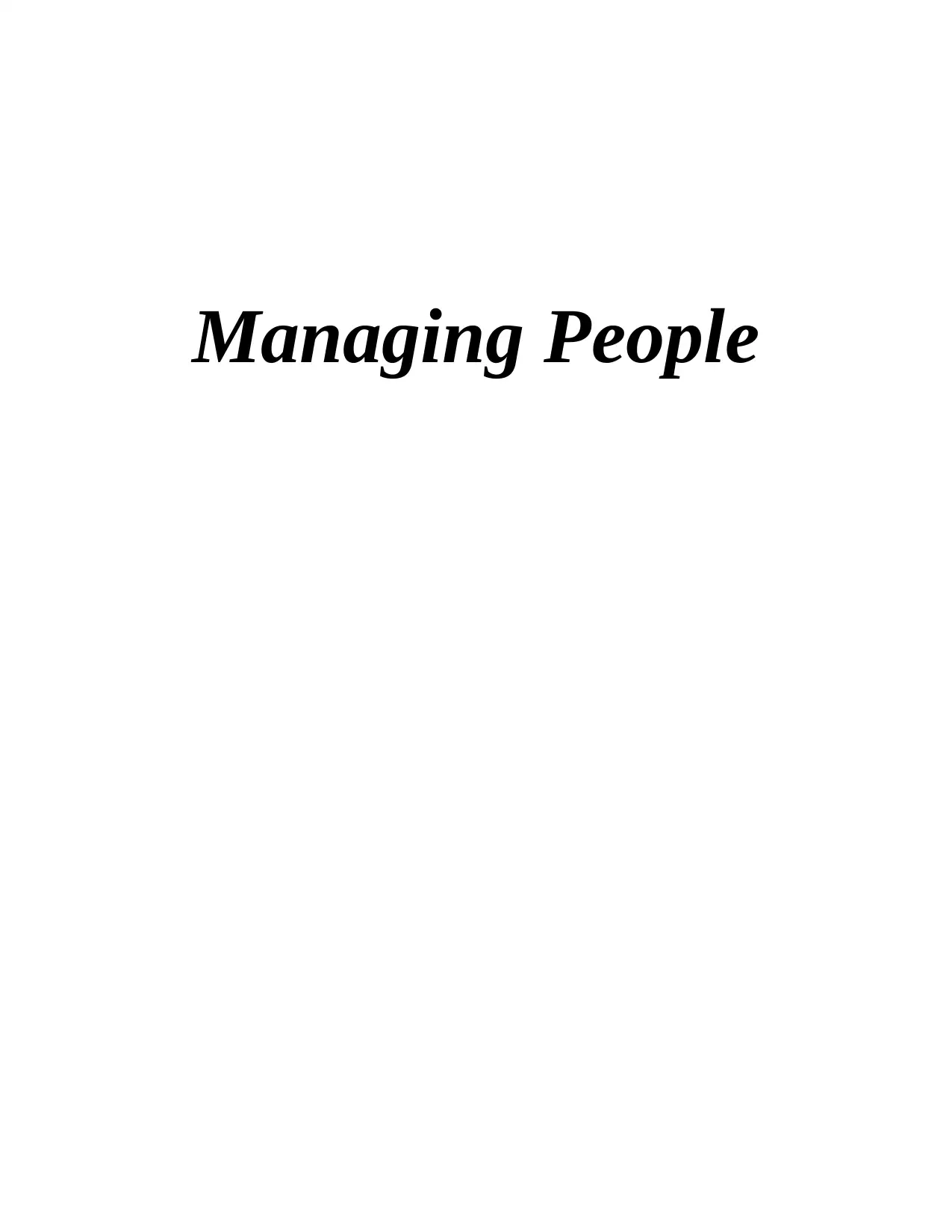
Managing People
Secure Best Marks with AI Grader
Need help grading? Try our AI Grader for instant feedback on your assignments.
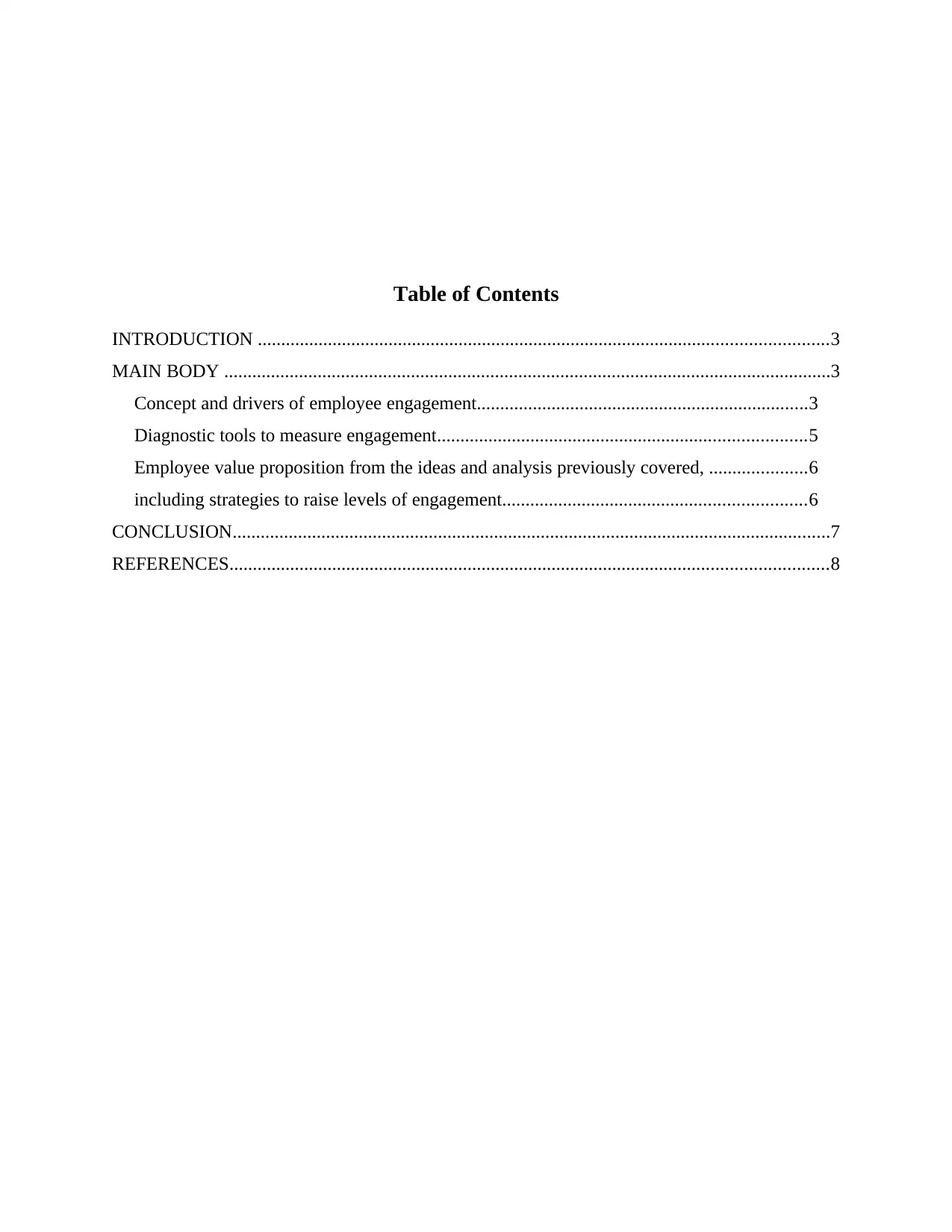
Table of Contents
INTRODUCTION ..........................................................................................................................3
MAIN BODY ..................................................................................................................................3
Concept and drivers of employee engagement.......................................................................3
Diagnostic tools to measure engagement...............................................................................5
Employee value proposition from the ideas and analysis previously covered, .....................6
including strategies to raise levels of engagement.................................................................6
CONCLUSION................................................................................................................................7
REFERENCES................................................................................................................................8
INTRODUCTION ..........................................................................................................................3
MAIN BODY ..................................................................................................................................3
Concept and drivers of employee engagement.......................................................................3
Diagnostic tools to measure engagement...............................................................................5
Employee value proposition from the ideas and analysis previously covered, .....................6
including strategies to raise levels of engagement.................................................................6
CONCLUSION................................................................................................................................7
REFERENCES................................................................................................................................8
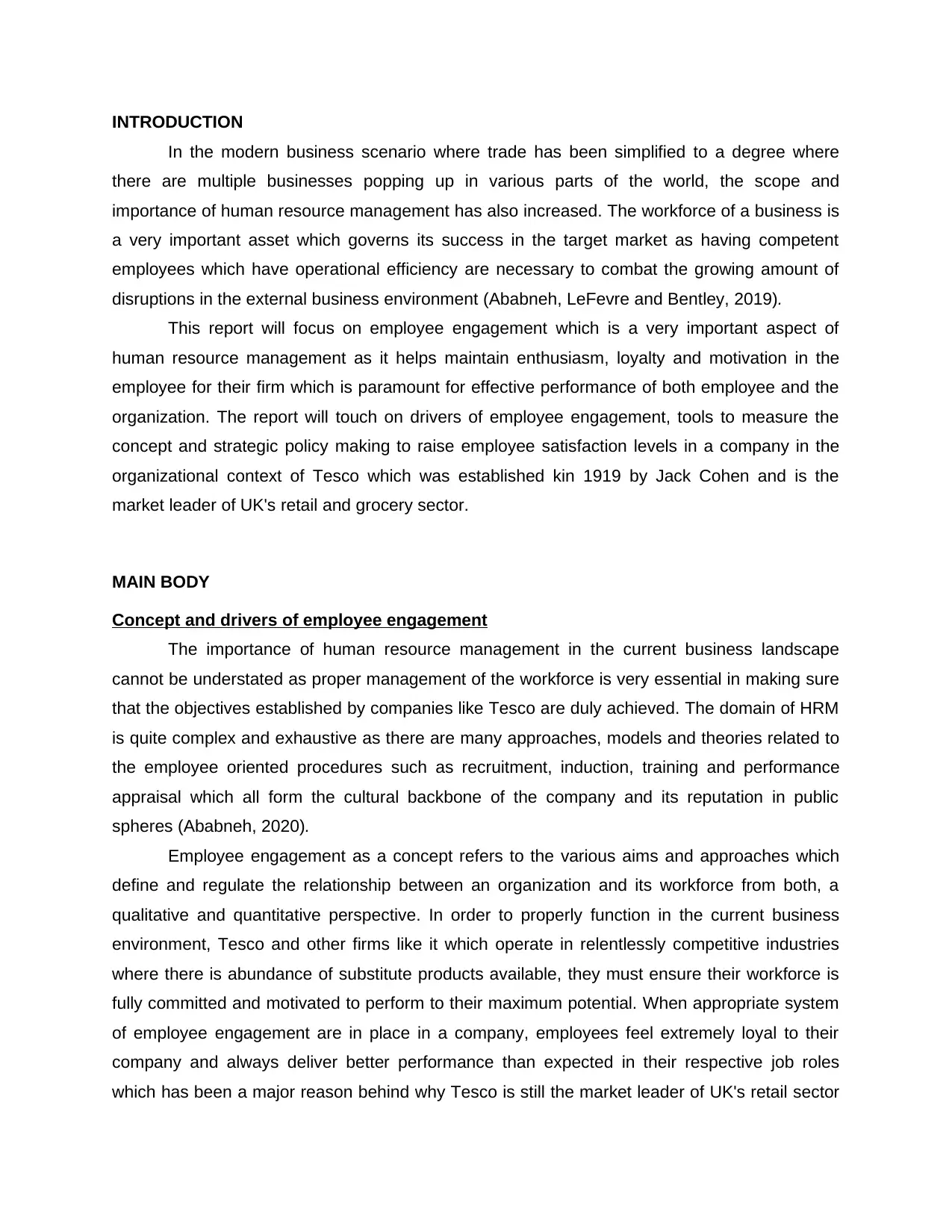
INTRODUCTION
In the modern business scenario where trade has been simplified to a degree where
there are multiple businesses popping up in various parts of the world, the scope and
importance of human resource management has also increased. The workforce of a business is
a very important asset which governs its success in the target market as having competent
employees which have operational efficiency are necessary to combat the growing amount of
disruptions in the external business environment (Ababneh, LeFevre and Bentley, 2019).
This report will focus on employee engagement which is a very important aspect of
human resource management as it helps maintain enthusiasm, loyalty and motivation in the
employee for their firm which is paramount for effective performance of both employee and the
organization. The report will touch on drivers of employee engagement, tools to measure the
concept and strategic policy making to raise employee satisfaction levels in a company in the
organizational context of Tesco which was established kin 1919 by Jack Cohen and is the
market leader of UK's retail and grocery sector.
MAIN BODY
Concept and drivers of employee engagement
The importance of human resource management in the current business landscape
cannot be understated as proper management of the workforce is very essential in making sure
that the objectives established by companies like Tesco are duly achieved. The domain of HRM
is quite complex and exhaustive as there are many approaches, models and theories related to
the employee oriented procedures such as recruitment, induction, training and performance
appraisal which all form the cultural backbone of the company and its reputation in public
spheres (Ababneh, 2020).
Employee engagement as a concept refers to the various aims and approaches which
define and regulate the relationship between an organization and its workforce from both, a
qualitative and quantitative perspective. In order to properly function in the current business
environment, Tesco and other firms like it which operate in relentlessly competitive industries
where there is abundance of substitute products available, they must ensure their workforce is
fully committed and motivated to perform to their maximum potential. When appropriate system
of employee engagement are in place in a company, employees feel extremely loyal to their
company and always deliver better performance than expected in their respective job roles
which has been a major reason behind why Tesco is still the market leader of UK's retail sector
In the modern business scenario where trade has been simplified to a degree where
there are multiple businesses popping up in various parts of the world, the scope and
importance of human resource management has also increased. The workforce of a business is
a very important asset which governs its success in the target market as having competent
employees which have operational efficiency are necessary to combat the growing amount of
disruptions in the external business environment (Ababneh, LeFevre and Bentley, 2019).
This report will focus on employee engagement which is a very important aspect of
human resource management as it helps maintain enthusiasm, loyalty and motivation in the
employee for their firm which is paramount for effective performance of both employee and the
organization. The report will touch on drivers of employee engagement, tools to measure the
concept and strategic policy making to raise employee satisfaction levels in a company in the
organizational context of Tesco which was established kin 1919 by Jack Cohen and is the
market leader of UK's retail and grocery sector.
MAIN BODY
Concept and drivers of employee engagement
The importance of human resource management in the current business landscape
cannot be understated as proper management of the workforce is very essential in making sure
that the objectives established by companies like Tesco are duly achieved. The domain of HRM
is quite complex and exhaustive as there are many approaches, models and theories related to
the employee oriented procedures such as recruitment, induction, training and performance
appraisal which all form the cultural backbone of the company and its reputation in public
spheres (Ababneh, 2020).
Employee engagement as a concept refers to the various aims and approaches which
define and regulate the relationship between an organization and its workforce from both, a
qualitative and quantitative perspective. In order to properly function in the current business
environment, Tesco and other firms like it which operate in relentlessly competitive industries
where there is abundance of substitute products available, they must ensure their workforce is
fully committed and motivated to perform to their maximum potential. When appropriate system
of employee engagement are in place in a company, employees feel extremely loyal to their
company and always deliver better performance than expected in their respective job roles
which has been a major reason behind why Tesco is still the market leader of UK's retail sector
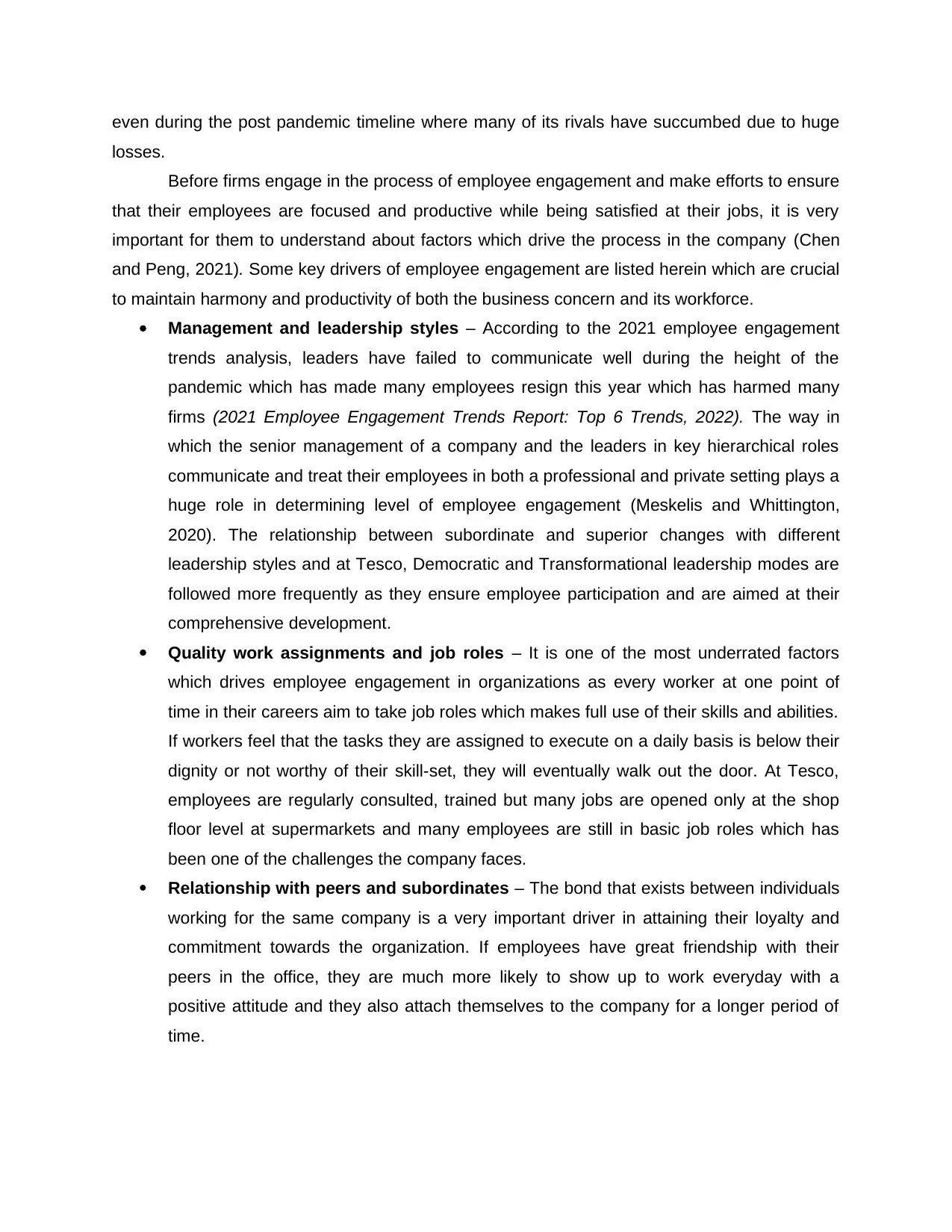
even during the post pandemic timeline where many of its rivals have succumbed due to huge
losses.
Before firms engage in the process of employee engagement and make efforts to ensure
that their employees are focused and productive while being satisfied at their jobs, it is very
important for them to understand about factors which drive the process in the company (Chen
and Peng, 2021). Some key drivers of employee engagement are listed herein which are crucial
to maintain harmony and productivity of both the business concern and its workforce.
Management and leadership styles – According to the 2021 employee engagement
trends analysis, leaders have failed to communicate well during the height of the
pandemic which has made many employees resign this year which has harmed many
firms (2021 Employee Engagement Trends Report: Top 6 Trends, 2022). The way in
which the senior management of a company and the leaders in key hierarchical roles
communicate and treat their employees in both a professional and private setting plays a
huge role in determining level of employee engagement (Meskelis and Whittington,
2020). The relationship between subordinate and superior changes with different
leadership styles and at Tesco, Democratic and Transformational leadership modes are
followed more frequently as they ensure employee participation and are aimed at their
comprehensive development.
Quality work assignments and job roles – It is one of the most underrated factors
which drives employee engagement in organizations as every worker at one point of
time in their careers aim to take job roles which makes full use of their skills and abilities.
If workers feel that the tasks they are assigned to execute on a daily basis is below their
dignity or not worthy of their skill-set, they will eventually walk out the door. At Tesco,
employees are regularly consulted, trained but many jobs are opened only at the shop
floor level at supermarkets and many employees are still in basic job roles which has
been one of the challenges the company faces.
Relationship with peers and subordinates – The bond that exists between individuals
working for the same company is a very important driver in attaining their loyalty and
commitment towards the organization. If employees have great friendship with their
peers in the office, they are much more likely to show up to work everyday with a
positive attitude and they also attach themselves to the company for a longer period of
time.
losses.
Before firms engage in the process of employee engagement and make efforts to ensure
that their employees are focused and productive while being satisfied at their jobs, it is very
important for them to understand about factors which drive the process in the company (Chen
and Peng, 2021). Some key drivers of employee engagement are listed herein which are crucial
to maintain harmony and productivity of both the business concern and its workforce.
Management and leadership styles – According to the 2021 employee engagement
trends analysis, leaders have failed to communicate well during the height of the
pandemic which has made many employees resign this year which has harmed many
firms (2021 Employee Engagement Trends Report: Top 6 Trends, 2022). The way in
which the senior management of a company and the leaders in key hierarchical roles
communicate and treat their employees in both a professional and private setting plays a
huge role in determining level of employee engagement (Meskelis and Whittington,
2020). The relationship between subordinate and superior changes with different
leadership styles and at Tesco, Democratic and Transformational leadership modes are
followed more frequently as they ensure employee participation and are aimed at their
comprehensive development.
Quality work assignments and job roles – It is one of the most underrated factors
which drives employee engagement in organizations as every worker at one point of
time in their careers aim to take job roles which makes full use of their skills and abilities.
If workers feel that the tasks they are assigned to execute on a daily basis is below their
dignity or not worthy of their skill-set, they will eventually walk out the door. At Tesco,
employees are regularly consulted, trained but many jobs are opened only at the shop
floor level at supermarkets and many employees are still in basic job roles which has
been one of the challenges the company faces.
Relationship with peers and subordinates – The bond that exists between individuals
working for the same company is a very important driver in attaining their loyalty and
commitment towards the organization. If employees have great friendship with their
peers in the office, they are much more likely to show up to work everyday with a
positive attitude and they also attach themselves to the company for a longer period of
time.
Secure Best Marks with AI Grader
Need help grading? Try our AI Grader for instant feedback on your assignments.
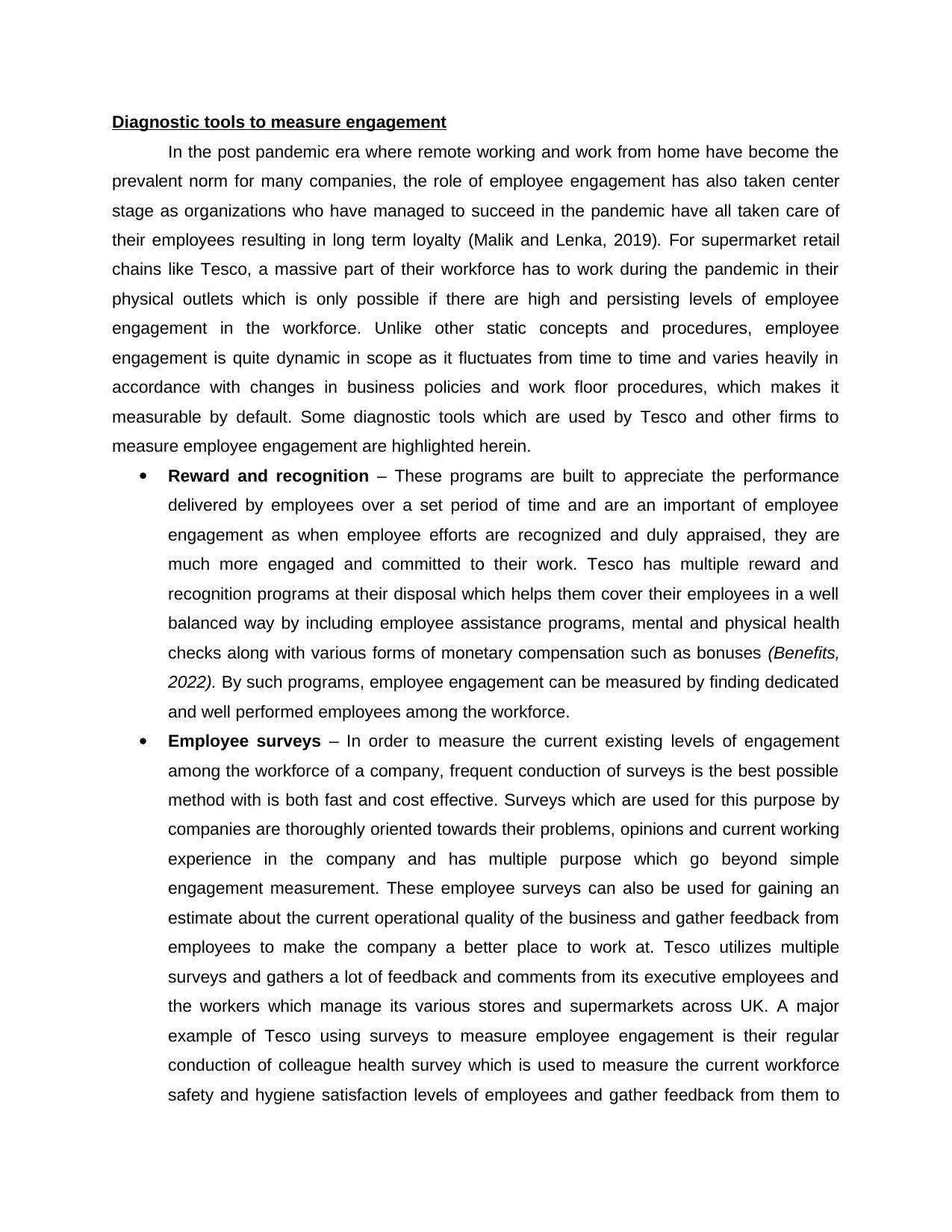
Diagnostic tools to measure engagement
In the post pandemic era where remote working and work from home have become the
prevalent norm for many companies, the role of employee engagement has also taken center
stage as organizations who have managed to succeed in the pandemic have all taken care of
their employees resulting in long term loyalty (Malik and Lenka, 2019). For supermarket retail
chains like Tesco, a massive part of their workforce has to work during the pandemic in their
physical outlets which is only possible if there are high and persisting levels of employee
engagement in the workforce. Unlike other static concepts and procedures, employee
engagement is quite dynamic in scope as it fluctuates from time to time and varies heavily in
accordance with changes in business policies and work floor procedures, which makes it
measurable by default. Some diagnostic tools which are used by Tesco and other firms to
measure employee engagement are highlighted herein.
Reward and recognition – These programs are built to appreciate the performance
delivered by employees over a set period of time and are an important of employee
engagement as when employee efforts are recognized and duly appraised, they are
much more engaged and committed to their work. Tesco has multiple reward and
recognition programs at their disposal which helps them cover their employees in a well
balanced way by including employee assistance programs, mental and physical health
checks along with various forms of monetary compensation such as bonuses (Benefits,
2022). By such programs, employee engagement can be measured by finding dedicated
and well performed employees among the workforce.
Employee surveys – In order to measure the current existing levels of engagement
among the workforce of a company, frequent conduction of surveys is the best possible
method with is both fast and cost effective. Surveys which are used for this purpose by
companies are thoroughly oriented towards their problems, opinions and current working
experience in the company and has multiple purpose which go beyond simple
engagement measurement. These employee surveys can also be used for gaining an
estimate about the current operational quality of the business and gather feedback from
employees to make the company a better place to work at. Tesco utilizes multiple
surveys and gathers a lot of feedback and comments from its executive employees and
the workers which manage its various stores and supermarkets across UK. A major
example of Tesco using surveys to measure employee engagement is their regular
conduction of colleague health survey which is used to measure the current workforce
safety and hygiene satisfaction levels of employees and gather feedback from them to
In the post pandemic era where remote working and work from home have become the
prevalent norm for many companies, the role of employee engagement has also taken center
stage as organizations who have managed to succeed in the pandemic have all taken care of
their employees resulting in long term loyalty (Malik and Lenka, 2019). For supermarket retail
chains like Tesco, a massive part of their workforce has to work during the pandemic in their
physical outlets which is only possible if there are high and persisting levels of employee
engagement in the workforce. Unlike other static concepts and procedures, employee
engagement is quite dynamic in scope as it fluctuates from time to time and varies heavily in
accordance with changes in business policies and work floor procedures, which makes it
measurable by default. Some diagnostic tools which are used by Tesco and other firms to
measure employee engagement are highlighted herein.
Reward and recognition – These programs are built to appreciate the performance
delivered by employees over a set period of time and are an important of employee
engagement as when employee efforts are recognized and duly appraised, they are
much more engaged and committed to their work. Tesco has multiple reward and
recognition programs at their disposal which helps them cover their employees in a well
balanced way by including employee assistance programs, mental and physical health
checks along with various forms of monetary compensation such as bonuses (Benefits,
2022). By such programs, employee engagement can be measured by finding dedicated
and well performed employees among the workforce.
Employee surveys – In order to measure the current existing levels of engagement
among the workforce of a company, frequent conduction of surveys is the best possible
method with is both fast and cost effective. Surveys which are used for this purpose by
companies are thoroughly oriented towards their problems, opinions and current working
experience in the company and has multiple purpose which go beyond simple
engagement measurement. These employee surveys can also be used for gaining an
estimate about the current operational quality of the business and gather feedback from
employees to make the company a better place to work at. Tesco utilizes multiple
surveys and gathers a lot of feedback and comments from its executive employees and
the workers which manage its various stores and supermarkets across UK. A major
example of Tesco using surveys to measure employee engagement is their regular
conduction of colleague health survey which is used to measure the current workforce
safety and hygiene satisfaction levels of employees and gather feedback from them to
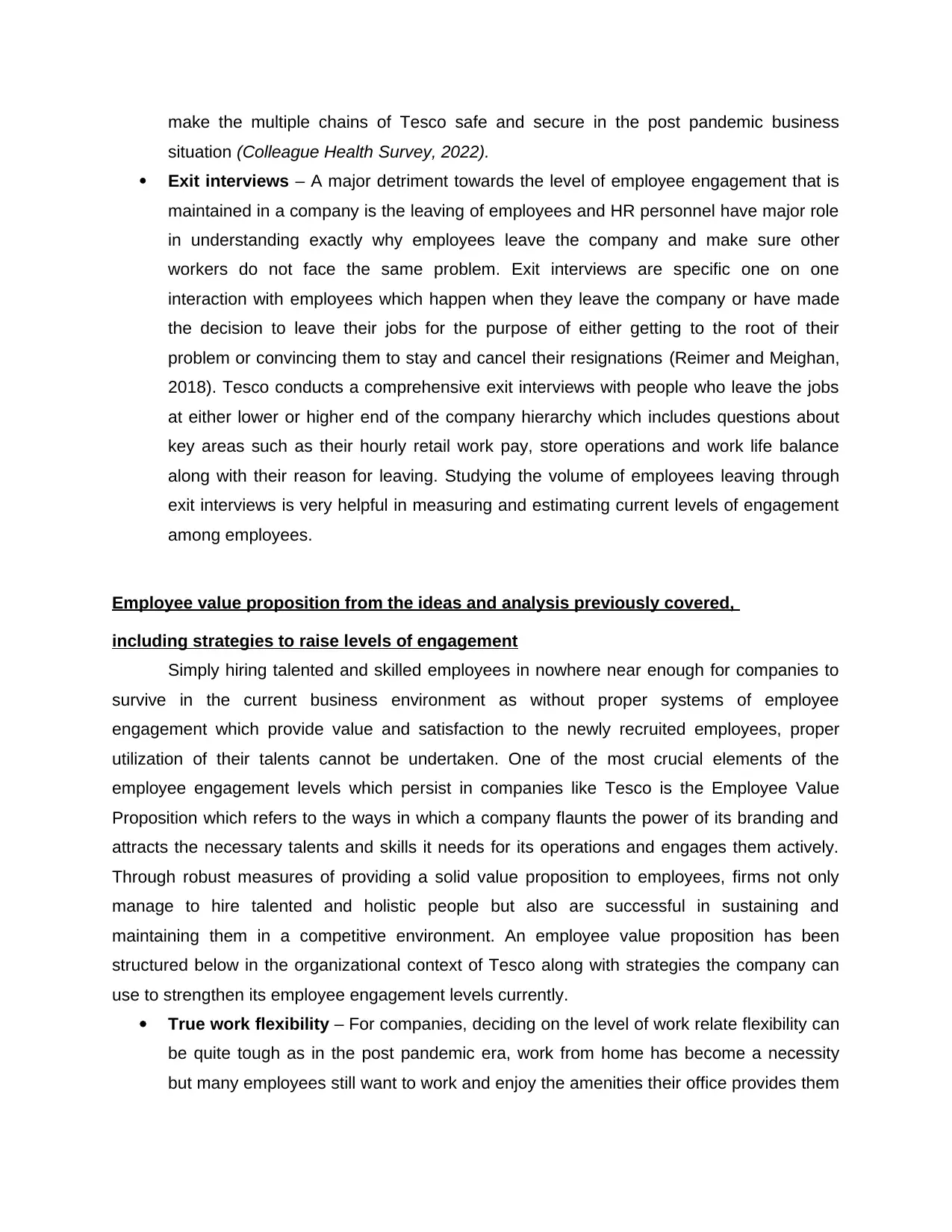
make the multiple chains of Tesco safe and secure in the post pandemic business
situation (Colleague Health Survey, 2022).
Exit interviews – A major detriment towards the level of employee engagement that is
maintained in a company is the leaving of employees and HR personnel have major role
in understanding exactly why employees leave the company and make sure other
workers do not face the same problem. Exit interviews are specific one on one
interaction with employees which happen when they leave the company or have made
the decision to leave their jobs for the purpose of either getting to the root of their
problem or convincing them to stay and cancel their resignations (Reimer and Meighan,
2018). Tesco conducts a comprehensive exit interviews with people who leave the jobs
at either lower or higher end of the company hierarchy which includes questions about
key areas such as their hourly retail work pay, store operations and work life balance
along with their reason for leaving. Studying the volume of employees leaving through
exit interviews is very helpful in measuring and estimating current levels of engagement
among employees.
Employee value proposition from the ideas and analysis previously covered,
including strategies to raise levels of engagement
Simply hiring talented and skilled employees in nowhere near enough for companies to
survive in the current business environment as without proper systems of employee
engagement which provide value and satisfaction to the newly recruited employees, proper
utilization of their talents cannot be undertaken. One of the most crucial elements of the
employee engagement levels which persist in companies like Tesco is the Employee Value
Proposition which refers to the ways in which a company flaunts the power of its branding and
attracts the necessary talents and skills it needs for its operations and engages them actively.
Through robust measures of providing a solid value proposition to employees, firms not only
manage to hire talented and holistic people but also are successful in sustaining and
maintaining them in a competitive environment. An employee value proposition has been
structured below in the organizational context of Tesco along with strategies the company can
use to strengthen its employee engagement levels currently.
True work flexibility – For companies, deciding on the level of work relate flexibility can
be quite tough as in the post pandemic era, work from home has become a necessity
but many employees still want to work and enjoy the amenities their office provides them
situation (Colleague Health Survey, 2022).
Exit interviews – A major detriment towards the level of employee engagement that is
maintained in a company is the leaving of employees and HR personnel have major role
in understanding exactly why employees leave the company and make sure other
workers do not face the same problem. Exit interviews are specific one on one
interaction with employees which happen when they leave the company or have made
the decision to leave their jobs for the purpose of either getting to the root of their
problem or convincing them to stay and cancel their resignations (Reimer and Meighan,
2018). Tesco conducts a comprehensive exit interviews with people who leave the jobs
at either lower or higher end of the company hierarchy which includes questions about
key areas such as their hourly retail work pay, store operations and work life balance
along with their reason for leaving. Studying the volume of employees leaving through
exit interviews is very helpful in measuring and estimating current levels of engagement
among employees.
Employee value proposition from the ideas and analysis previously covered,
including strategies to raise levels of engagement
Simply hiring talented and skilled employees in nowhere near enough for companies to
survive in the current business environment as without proper systems of employee
engagement which provide value and satisfaction to the newly recruited employees, proper
utilization of their talents cannot be undertaken. One of the most crucial elements of the
employee engagement levels which persist in companies like Tesco is the Employee Value
Proposition which refers to the ways in which a company flaunts the power of its branding and
attracts the necessary talents and skills it needs for its operations and engages them actively.
Through robust measures of providing a solid value proposition to employees, firms not only
manage to hire talented and holistic people but also are successful in sustaining and
maintaining them in a competitive environment. An employee value proposition has been
structured below in the organizational context of Tesco along with strategies the company can
use to strengthen its employee engagement levels currently.
True work flexibility – For companies, deciding on the level of work relate flexibility can
be quite tough as in the post pandemic era, work from home has become a necessity
but many employees still want to work and enjoy the amenities their office provides them
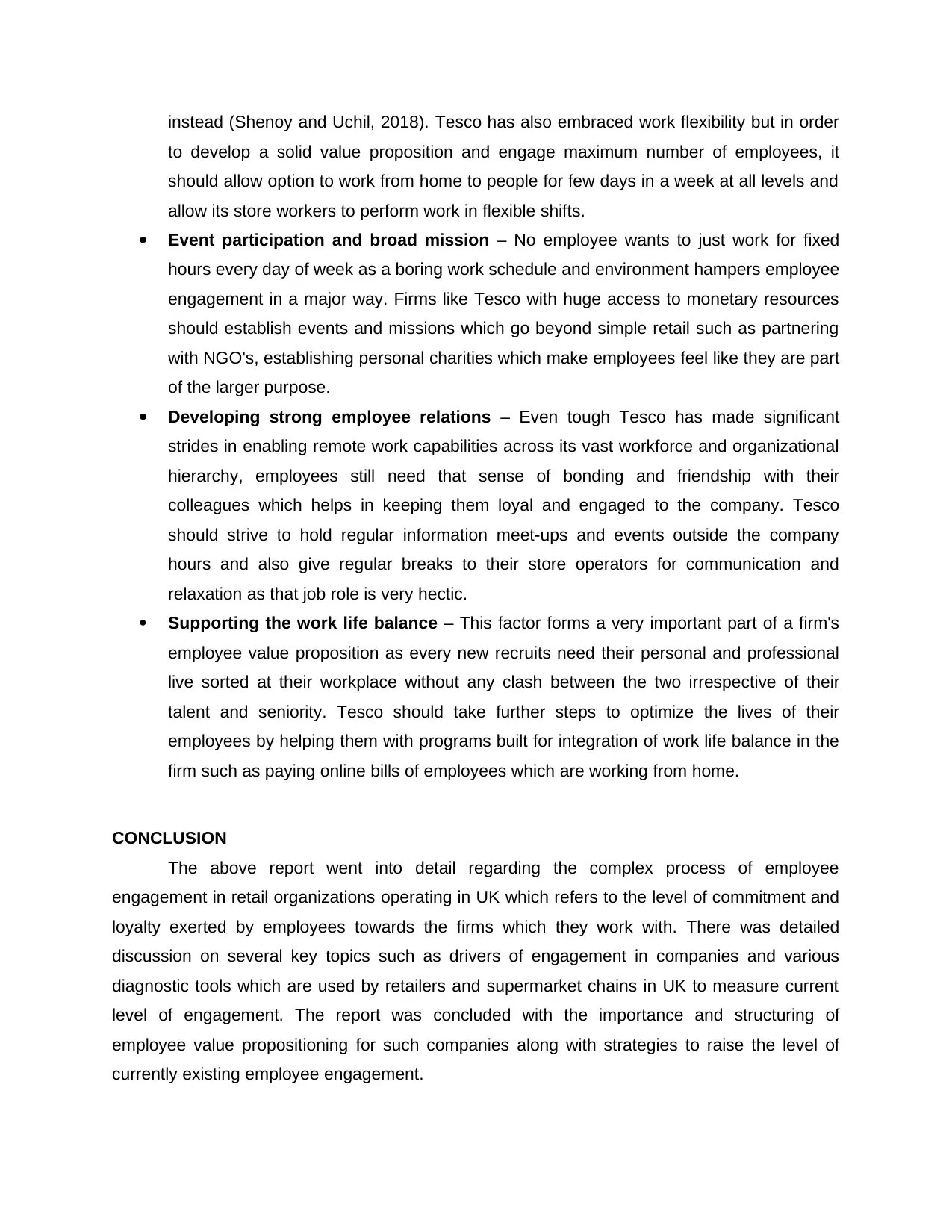
instead (Shenoy and Uchil, 2018). Tesco has also embraced work flexibility but in order
to develop a solid value proposition and engage maximum number of employees, it
should allow option to work from home to people for few days in a week at all levels and
allow its store workers to perform work in flexible shifts.
Event participation and broad mission – No employee wants to just work for fixed
hours every day of week as a boring work schedule and environment hampers employee
engagement in a major way. Firms like Tesco with huge access to monetary resources
should establish events and missions which go beyond simple retail such as partnering
with NGO's, establishing personal charities which make employees feel like they are part
of the larger purpose.
Developing strong employee relations – Even tough Tesco has made significant
strides in enabling remote work capabilities across its vast workforce and organizational
hierarchy, employees still need that sense of bonding and friendship with their
colleagues which helps in keeping them loyal and engaged to the company. Tesco
should strive to hold regular information meet-ups and events outside the company
hours and also give regular breaks to their store operators for communication and
relaxation as that job role is very hectic.
Supporting the work life balance – This factor forms a very important part of a firm's
employee value proposition as every new recruits need their personal and professional
live sorted at their workplace without any clash between the two irrespective of their
talent and seniority. Tesco should take further steps to optimize the lives of their
employees by helping them with programs built for integration of work life balance in the
firm such as paying online bills of employees which are working from home.
CONCLUSION
The above report went into detail regarding the complex process of employee
engagement in retail organizations operating in UK which refers to the level of commitment and
loyalty exerted by employees towards the firms which they work with. There was detailed
discussion on several key topics such as drivers of engagement in companies and various
diagnostic tools which are used by retailers and supermarket chains in UK to measure current
level of engagement. The report was concluded with the importance and structuring of
employee value propositioning for such companies along with strategies to raise the level of
currently existing employee engagement.
to develop a solid value proposition and engage maximum number of employees, it
should allow option to work from home to people for few days in a week at all levels and
allow its store workers to perform work in flexible shifts.
Event participation and broad mission – No employee wants to just work for fixed
hours every day of week as a boring work schedule and environment hampers employee
engagement in a major way. Firms like Tesco with huge access to monetary resources
should establish events and missions which go beyond simple retail such as partnering
with NGO's, establishing personal charities which make employees feel like they are part
of the larger purpose.
Developing strong employee relations – Even tough Tesco has made significant
strides in enabling remote work capabilities across its vast workforce and organizational
hierarchy, employees still need that sense of bonding and friendship with their
colleagues which helps in keeping them loyal and engaged to the company. Tesco
should strive to hold regular information meet-ups and events outside the company
hours and also give regular breaks to their store operators for communication and
relaxation as that job role is very hectic.
Supporting the work life balance – This factor forms a very important part of a firm's
employee value proposition as every new recruits need their personal and professional
live sorted at their workplace without any clash between the two irrespective of their
talent and seniority. Tesco should take further steps to optimize the lives of their
employees by helping them with programs built for integration of work life balance in the
firm such as paying online bills of employees which are working from home.
CONCLUSION
The above report went into detail regarding the complex process of employee
engagement in retail organizations operating in UK which refers to the level of commitment and
loyalty exerted by employees towards the firms which they work with. There was detailed
discussion on several key topics such as drivers of engagement in companies and various
diagnostic tools which are used by retailers and supermarket chains in UK to measure current
level of engagement. The report was concluded with the importance and structuring of
employee value propositioning for such companies along with strategies to raise the level of
currently existing employee engagement.
Paraphrase This Document
Need a fresh take? Get an instant paraphrase of this document with our AI Paraphraser
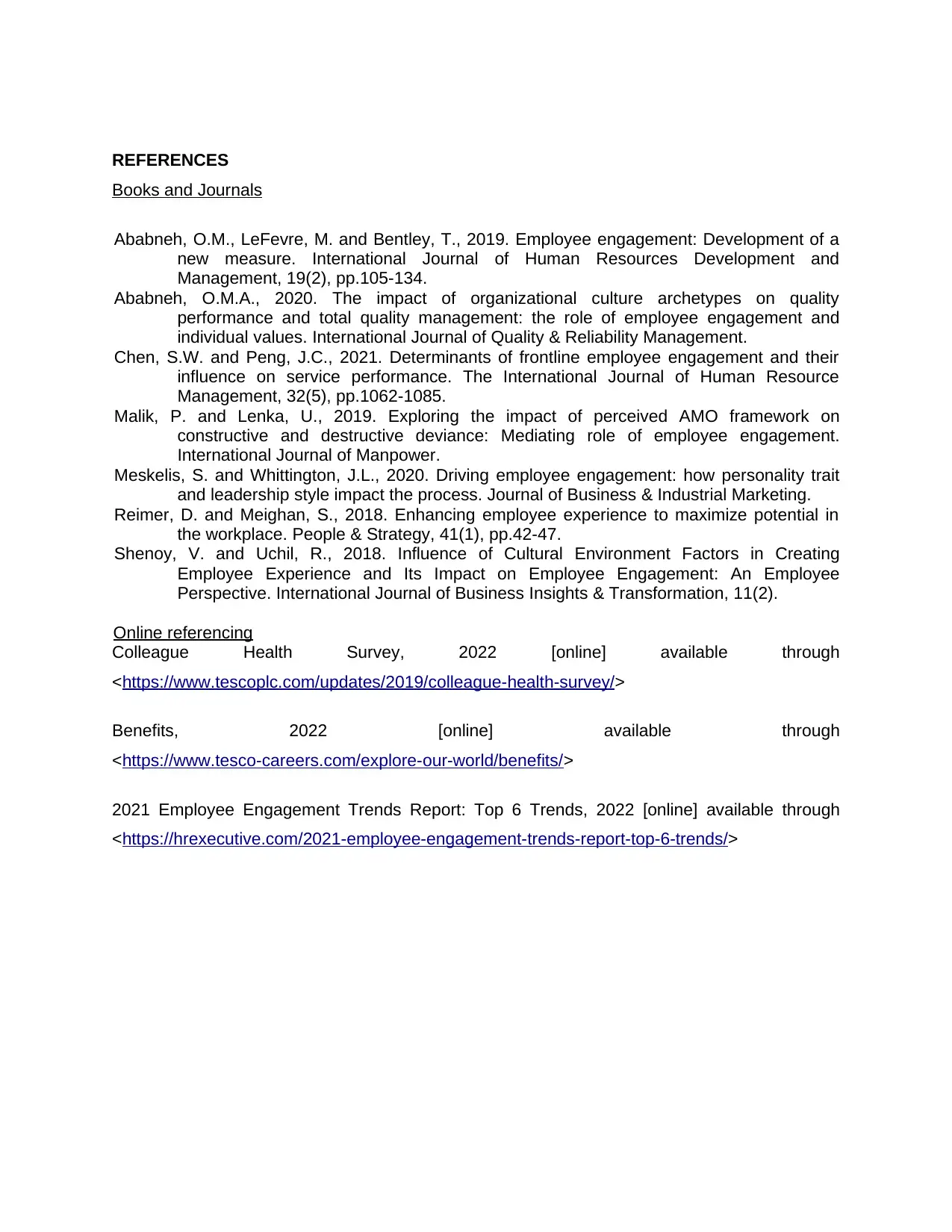
REFERENCES
Books and Journals
Ababneh, O.M., LeFevre, M. and Bentley, T., 2019. Employee engagement: Development of a
new measure. International Journal of Human Resources Development and
Management, 19(2), pp.105-134.
Ababneh, O.M.A., 2020. The impact of organizational culture archetypes on quality
performance and total quality management: the role of employee engagement and
individual values. International Journal of Quality & Reliability Management.
Chen, S.W. and Peng, J.C., 2021. Determinants of frontline employee engagement and their
influence on service performance. The International Journal of Human Resource
Management, 32(5), pp.1062-1085.
Malik, P. and Lenka, U., 2019. Exploring the impact of perceived AMO framework on
constructive and destructive deviance: Mediating role of employee engagement.
International Journal of Manpower.
Meskelis, S. and Whittington, J.L., 2020. Driving employee engagement: how personality trait
and leadership style impact the process. Journal of Business & Industrial Marketing.
Reimer, D. and Meighan, S., 2018. Enhancing employee experience to maximize potential in
the workplace. People & Strategy, 41(1), pp.42-47.
Shenoy, V. and Uchil, R., 2018. Influence of Cultural Environment Factors in Creating
Employee Experience and Its Impact on Employee Engagement: An Employee
Perspective. International Journal of Business Insights & Transformation, 11(2).
Online referencing
Colleague Health Survey, 2022 [online] available through
<https://www.tescoplc.com/updates/2019/colleague-health-survey/>
Benefits, 2022 [online] available through
<https://www.tesco-careers.com/explore-our-world/benefits/>
2021 Employee Engagement Trends Report: Top 6 Trends, 2022 [online] available through
<https://hrexecutive.com/2021-employee-engagement-trends-report-top-6-trends/>
Books and Journals
Ababneh, O.M., LeFevre, M. and Bentley, T., 2019. Employee engagement: Development of a
new measure. International Journal of Human Resources Development and
Management, 19(2), pp.105-134.
Ababneh, O.M.A., 2020. The impact of organizational culture archetypes on quality
performance and total quality management: the role of employee engagement and
individual values. International Journal of Quality & Reliability Management.
Chen, S.W. and Peng, J.C., 2021. Determinants of frontline employee engagement and their
influence on service performance. The International Journal of Human Resource
Management, 32(5), pp.1062-1085.
Malik, P. and Lenka, U., 2019. Exploring the impact of perceived AMO framework on
constructive and destructive deviance: Mediating role of employee engagement.
International Journal of Manpower.
Meskelis, S. and Whittington, J.L., 2020. Driving employee engagement: how personality trait
and leadership style impact the process. Journal of Business & Industrial Marketing.
Reimer, D. and Meighan, S., 2018. Enhancing employee experience to maximize potential in
the workplace. People & Strategy, 41(1), pp.42-47.
Shenoy, V. and Uchil, R., 2018. Influence of Cultural Environment Factors in Creating
Employee Experience and Its Impact on Employee Engagement: An Employee
Perspective. International Journal of Business Insights & Transformation, 11(2).
Online referencing
Colleague Health Survey, 2022 [online] available through
<https://www.tescoplc.com/updates/2019/colleague-health-survey/>
Benefits, 2022 [online] available through
<https://www.tesco-careers.com/explore-our-world/benefits/>
2021 Employee Engagement Trends Report: Top 6 Trends, 2022 [online] available through
<https://hrexecutive.com/2021-employee-engagement-trends-report-top-6-trends/>
1 out of 8
Related Documents
Your All-in-One AI-Powered Toolkit for Academic Success.
+13062052269
info@desklib.com
Available 24*7 on WhatsApp / Email
![[object Object]](/_next/static/media/star-bottom.7253800d.svg)
Unlock your academic potential
© 2024 | Zucol Services PVT LTD | All rights reserved.




